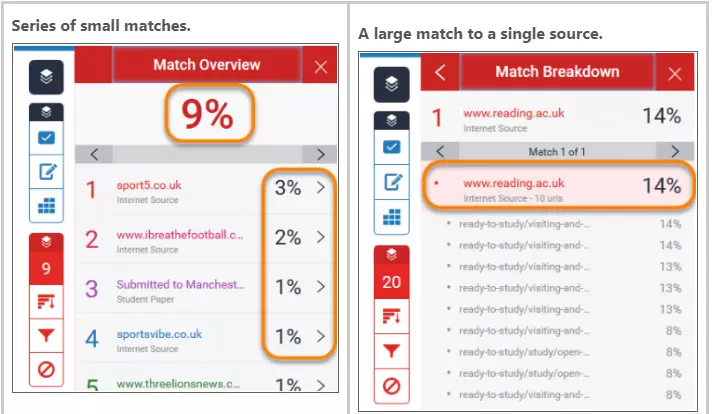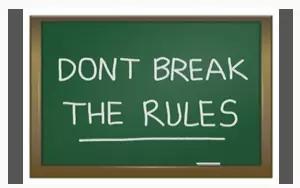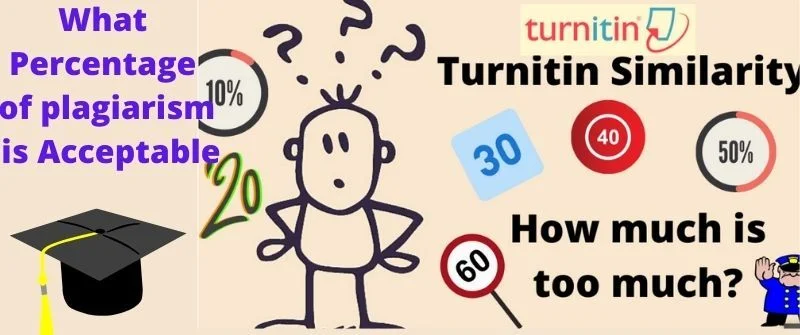Plagiarism is a type of academic fraud or cheating. It typically involves the use of someone’s work, whether published or unpublished, without the permission of the author or creator.
While plagiarism does not necessarily involve breaking the law, it is widely considered to be unethical and unacceptable in the academic, business, and wider communities.
A significant range of penalties exists for plagiarism, depending on the severity of the offense, the type of plagiarism, and the jurisdiction within which an offense takes place.
As much as plagiarism is wrong, sometimes it is unavoidable and thus there is an acceptable plagiarism percentage.
What Percentage of Plagiarism is Acceptable
The allowed similarity score varies from institution to institution. For instance, it may be acceptable to have a certain percentage of a college research paper deemed plagiarized, but it would be acceptable for high school essays.
The acceptable plagiarism percentage is any score of 15% and below because this similarity shows little or low or no copying.
However, there is no widely accepted criteria on which plagiarism level is acceptable because different industries and institutions have different originality policies.
However, the plagiarism percentage you should avoid at all times is more than 15%. Any percentage above that will be enough to get you into trouble.
For instance, if you have 15% plagiarism in a research paper, then you have the risk to be reported by your tutor for academic dishonesty. In a nutshell, the acceptable plagiarism percentage is between 0 and 15% for all kinds of papers.
What Every Percentage Score Means
A summary of matching or substantially similar text detected in a submitted paper is provided in a Similarity Report. A similarity score percentage will be displayed when a Similarity Report is available for viewing.

A grayed-out icon in the Similarity column represents Similarity Reports that have not yet completed generating. Reports that aren’t available may not have yet been generated, or assignment settings may be preventing the report from being generated.
The report icon’s color represents the paper’s similarity score, which is calculated on the basis of matching or comparable text found. The following are some probable similarity ranges from 0% to 100%.
- Blue: there is no matching text
- Green: A single word to 24% matching text.
- Yellow: Text that matches 25-49%
- Orage: Text matching 50-74%
- Red: indicates that the text is 75-100 percent identical
Factors Determining Acceptable Plagiarism Score
The percentage of plagiarism is a critical issue for students, teachers, and educational institutions. In some cases, plagiarism is an accidental mistake, but in the majority of cases, it is a deliberate action.

Considering research papers are one of the most important factors that determine your grade, they must be crafted without plagiarism.
Most academic industries, faculties, and professors have developed an extensive guide on what percentage of plagiarism is acceptable in different situations.
Here will go over the factors that determine the percentage of plagiarism acceptable in research papers.
1. Your Field of Study
In colleges or universities, there are several fields of students each with its own running and set of rules and regulations. Since these filed are independent, their acceptable plagiarism percentage varies.
For example for a law student, a plagiarism percentage of 10% is already a very serious matter whereas such a percentage may be acceptable in other fields.
It is also important to note that fields that deal with factual scientific data (sciences and maths), may accept a large plagiarism percentage than other fields.
2. The Type of Assignment
When it comes to plagiarism, different types of assignments have different acceptable plagiarism percentages
That means the acceptable plagiarism percentage varies based on the type of assignment, and this is because while some types of assignments can be completed in a short time, others take up a lot of time.
For example, while a 5% plagiarized book review will get you a failing grade, a 5% plagiarized term paper will get you a passing grade.
Additionally, there are many different types of papers, and there are many different types of assignments. Sometimes an assignment will have a different requirement than another.
For example, a term paper will have a much higher acceptable plagiarism percentage than a 500-word essay.
3. The Strictness of Your Professor
How strict your professor is, is also a factor that determines how much plagiarism percentage you are allowed. This all boils down to the choices and preferences of your instructor.
Professors with a strict grading policy will tell you to keep the plagiarism percentage as low as 1% while those with a lenient grading policy may accept even original papers with 25% similarity score. However, to be on the safer side, also ensure you keep your plagiarism as low (less than 5%)
The Strictness of Sour school Rules

Different institutions of study have different rules and policies.
For example, there are those schools that require their grading be made by the institution itself as opposed to those who task individual professors with the grading.
Again, some colleges require papers to be marked and reviewed by a panel of professors who will then award you the grade.
Other schools have a portal where you submit your paper, and the portal has strict guidelines (such as acceptable plagiarism percentage) which the professor uses to grade your paper. All these school factors determine the acceptable plagiarism percentage.
Conclusion
Technically, plagiarism is wrong. However, there is an acceptable percentage of plagiarism that is allowed. The acceptable percentage of plagiarism is considered to be 10%. If you go beyond that percentage, then your thesis will be plagiarized.
If you do not want to be accused of plagiarism, then avoid copying the work of others. Either cite your sources or paraphrase the idea of others. Even when giving a speech, you can avoid patchwork plagiarism by citing your sources while speaking.
You can do this if you use quotation marks correctly. Note that you should always referee to your school guidelines to avoid severe plagiarism consequences.
FAQs
What is the acceptable plagiarism percentage for Turnitin?
Turnitin does not have an acceptable percentage threshold for plagiarism. There are two elements that are assessed when you submit work to Turnitin to check for originality. The first is the text itself, and the second is the structure or design, so plagiarism is assessed by both the text and the presentation.
However, Turnitin levels of 15% or less are widely considered appropriate. It is also important to note that there is no universally defined similarity score because plagiarism policies differ by institution.
Is 32 similarity on Turnitin bad?
32 similarity is usually the maximum similarity level the Turnitin system will determine. It means that at least 32% of your paper is plagiarized from existing sources. You should check your paper as soon as possible.
If your paper is not your own work, you may face serious consequences. The Turnitin system is used by most universities and colleges, so if your instructor catches you cheating, you will be expelled without a doubt.
What is the acceptable plagiarism percentage for a thesis?
According to various universities, students are advised to avoid plagiarism as much as possible. The acceptable level of plagiarism varies from university to university.
Some universities accept 25% or even 20% plagiarism, while others say it should not exceed 5%. To avoid your paper not being accepted, refer to your university guideline and apply the percentage of plagiarism that you are allowed to use.
What percentage of plagiarism is acceptable by Google?
The answer to this question is not yet clear. Google’s policy about duplicate content is very strict these days. You should avoid repeating the same content on your web pages. But it doesn’t mean you cannot copy the content from other websites.
The best thing is to share the knowledge with your visitors. Don’t forget, Google is a search engine that generates data from the web. You can use aggregation in your favor. You can add links to the original content when you re-share the information.

Joseph is a freelance journalist and a part-time writer with a particular interest in the gig economy. He writes about schooling, college life, and changing trends in education. When not writing, Joseph is hiking or playing chess.
